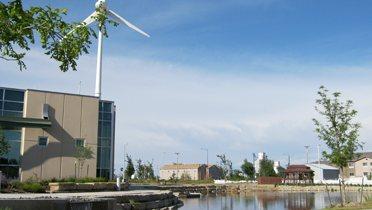With Washington mired in unproductive argument this fall, it’s a great time to look elsewhere in America for smart, constructive problem-solving.
Specifically, it’s a great time–in the realm of energy policy–to look at what’s going on in U.S. states, many of which have been at the forefront of implementing innovative clean energy solutions.
Which is why my group at the Metropolitan Policy Program at Brookings (working with the team at Ken’s Coalition for Green Capital) just posted a new brief this morning on the growing interest among multiple states in state-level clean energy finance banking—a new innovation in U.S. energy finance and sub-national pragmatism.
Written by Reed Hundt of the coalition, Devashree Saha, and ourselves, the new brief (part of our Brookings-Rockefeller Project on State and Metropolitan Innovation) describes Connecticut’s path-breaking design of the nation’s first “green” bank and proposes ways other states might get into the act.
They probably need to. Financing the broad deployment of clean new energy and energy efficiency solutions remains one today’s most challenging energy policy problems.
Energy efficiency projects remain complicated to finance given their large up-front costs and the limited capital resources available to consumers while the delivered cost of energy from renewable energy projects–even though its has been dropping rapidly–is still generally more expensive than the delivered cost of energy from conventional sources, making the widespread deployment of these projects problematic. Most notably, clean solutions tend to falter in the marketplace because neither their full social benefits not their dirtier competitors’ full social costs are priced in, leaving those dirtier solutions cheaper.
Yet, here is where Connecticut innovated. By consolidating several existing programs into a new quasi-public corporation and then securing for the new entity the ability to raise and leverage funds from private sources, the state set up the nation’s first clean energy finance bank to leverage scarce public dollars with private capital so as to provide a combination of low-interest rate funding for clean energy projects and low-cost up-front loans for energy efficiency projects.
The result was the Connecticut Clean Energy Finance and Investment Authority, and over the last year the new entity has been making progress at transitioning Connecticut’s clean energy programs away from relatively expensive grants, rebates, and other subsidies toward the attraction and deployment of private capital to finance commercially available clean energy technologies. Though the start-up has been slower than hoped for the concept remains promising. And so in this way, Gov. Dannel Malloy, Energy and Environment Commissioner Dan Esty, and the state’s legislature have scored what appears to be a significant institutional and finance breakthrough on one of the truly hard problems.
Drawing on such models as the Overseas Private Investment Corporation, the Export-Import Bank, and several foreign examples, such as U.K.’s Green Investment Bank and Australia’s proposed Clean Energy Finance Corporation, a determined U.S. state has pushed ahead, and now other states are interested.
Work is getting done and our paper seeks to suggest a variety of ways interested other states can design their own clean energy finance authorities beginning from their own starting points. In the vein, while some states may need—like Connecticut—to establish a new quasi-public corporation into which to gather existing funds and then leverage them, other states may prefer to repurpose an existing finance authority or adjust an existing state-level infrastructure bank so as to attach a clean energy finance bank. Others, moreover, may want to attach to their finance entity a special “innovation window” to provide financing solutions for scaling up riskier emerging technologies.
There are many ways to proceed and states are looking at all of them, just as they have embraced the important concept of state-level infrastructure banks, as reviewed in a companion paper by my colleague Rob Puentes.
In a way, then, the new paper represents a more encouraging follow-up to the story of pending federal policy roll-back I told earlier this year with colleagues from the World Resources and Breakthrough institutes.
Though Washington is gridlocked and retrenching, states are stepping up and inventing–once again. In that sense, clean energy, or “green,” finance banks look a lot like American federalism at its best.






Commentary
Banking on the States for Clean Energy Innovation
September 12, 2012